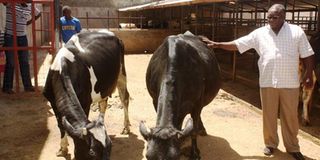From a simple dairy farm to a cash cow

Geoffrey Kinyanjui in his dairy farm in Naivasha. PHOTO | MACHARIA MWANGI |
What you need to know:
- It’s dream come true for Kinyanjui who started with two cows but now makes yoghurt and purifies water.
With its udder seemingly about to burst, the dairy cow named Kayole leaves its shed walking in measured steps as if it is in a beauty contest.
It stands at a wheelbarrow full of hay on the farm in Naivasha and starts to chew the fodder before it is led into a milking shed.
It it is about 4pm and this is the third time its handler is milking the Friesian cow that is the toast of the farm because it produces an average of 40 litres of milk a day.
“Its big udder makes it difficult for it to walk, thus, the measured steps that have made some of my friends describe it as proud,” says Geoffrey Kinyanjui, the owner of the farm.
The animal is his favourite at the farm that hosts 28 dairy cows, 11 of which are lactating, each producing an average of 25 to 40 litres a day.
Kinyanjui attributes the difference in milk production between Kayole and the others to feeds and genetics.
The thirst to supply milk to neighbours and earn extra money to boost his earnings made Kinyanjui venture into dairy farming in 2010. Living in the peri-urban Kayole estate in Naivasha, getting fresh milk was a challenge for residents. Kinyanjui saw a commercial opportunity.
Armed with Sh140,000, the draughtsman bought two dairy cows from a farm in Kinangop after building a shed.
“The two cows produced more than 40 litres per day but this was not enough to supply to my clients,” he recounts.
With demand rising, Kinyanjui increased his herd about a year later to four.
However, that proved to be only a temporary measure as demand for milk kept on rising.
“I realised that the only way to satisfy the demand was to go commercial by increasing my herd and expanding my zero-grazing units.”
His architectural background came in handy. He built modern zero-grazing units on a quarter of his three-acre farm, which also doubles as the family homestead.
CLEANED TWICE A DAY
The beauty of his architectural ingenuity is laid bare as one enters the zero-grazing unit.
Each cow has a cubicle for feeding, with the troughs made of concrete. The resting cubicles a few metres away, on the other hand, ensure the comfort of the 28 animals that have multiplied from four in the past five years.
“I have two full-time workers who clean the pens every day. A pen must be cleaned even twice a day to remove dung and slurry which cause diseases like mastitis,” says Kinyanjui, adding that his cows have not been affected by major diseases due to good hygiene and because he contracts a veterinary officer to check on them regularly.
The lactating herd gives him an average of 250 litres a day that he sells at Sh60 a litre in Naivasha Town.
MAKING YOGHURT
He feeds the animals mainly on hay he buys from Delamare Estates and other concentrates amounting to the 25 per cent of the daily ration as recommended. He sells some of the milk raw and adds value to the other by making yoghurt.
“I have contracted several farmers from Kinangop who supply me 1,800 litres of milk for my yoghurt business. I have been making yoghurt manually, processing 800 litres a day, but I am in the process of acquiring a mini-plant valued at Sh10 million to boost my production to 8,000 litres,” says Kinyanjui of the processing plant located in his farm.
To make yoghurt, he uses the following ingredients: fresh milk, food colours and flavours. They are mixed, heated and then cooled. His yoghurt, which is certified by the Kenya Bureau of Standards, is branded Queency and he sells half a litre at Sh70 in Naivasha and in Kiambu.
“I am yet to (meet the needs) of any of my markets, but I remain hopeful that the purchase of the mini-plant will be my turning point.”
Kinyanjui says he has hired four fully qualified Dairy Training Institute graduates to help produce yoghurt.
His greatest impediment remains frequent power outages, which he says slow his production capacity. The current dry spell has also hit hard the milk production of farmers who supply him with the produce, making him cut yoghurt production.
The farmer further sells heifers at no less than Sh200,000.
Kinyanjui has diversified his business into water purification, riding on the success of his dairy unit.“From my healthy dairy farming bank account, I was able to secure a loan from the bank to undertake water purification.”
Though still nascent, the Sh1 million business looks promising as the farmer has sunk a borehole and has started selling purified water at Sh30 for a 500ml bottle, pulling another first among the community members.
“Currently, my market is mainly Naivasha Town, but I am in the process of looking for distributors to market my Queency water brand.” Dr Titus Lanyasunya, the director of the Dairy Research Institute in Naivasha, says making homemade yoghurt is an easy process that any farmer can do to boost his earnings.
“You need to heat the milk to 72 degrees centigrade for at least three minutes or until it starts to bubble. Stir the milk gently as it heats to make sure the milk does not boil over. Heating the milk changes the protein structure so that it sets as a solid instead of separating thereby improving the consistency of the resulting yoghurt. This is the basic, but one needs lessons particularly on using food colour and flavour.”





